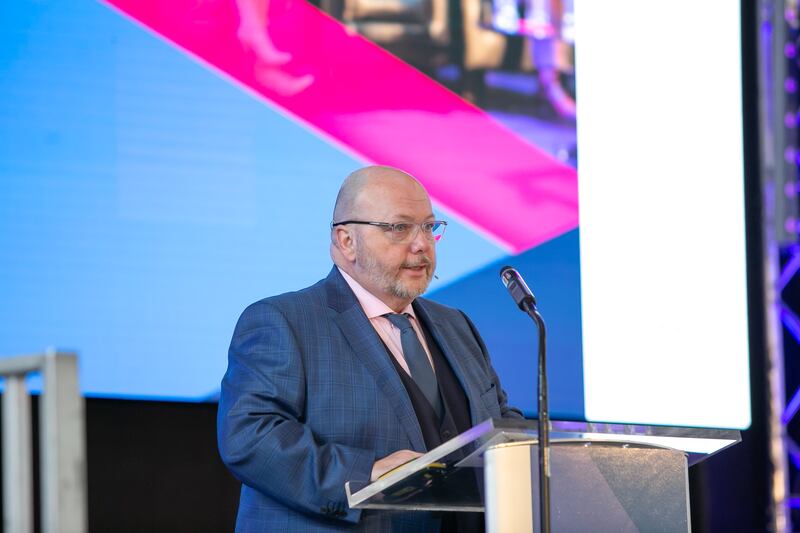Declan O’Shea was on holiday in Portugal in 2011 when he fell off a third-floor balcony while sleepwalking. He ended up in a coma for two weeks. When he woke, he couldn’t move any of his limbs and he was given the devastating news that he had broken his neck.
After a long, gruelling period of rehabilitation that is still ongoing, Declan, who is now 36, has gained back the strength in his arms but he suffered a complete spinal injury and is now quadriplegic.
“I had been in Portugal for the weekend with a couple of mates for a motorbike race.
“When the accident happened, my wife had to get the next flight out. I don’t think anybody in the hospital there ever said I would never walk again but we knew it was not good.
“I went into a black depression at the start. I couldn’t get my head around it. The worst day was when I had been transferred back to the Mater hospital and I was told it was a complete injury.
“It if had been an incomplete injury, I might have got some movement back in my legs, but there was no hope. I will never forget that day.”
Declan and his wife, Helena, who live in Kilmihil, Co Clare, had always planned to have children and they had no intention of letting his disability change those plans.
On March 26th, their baby twins, Asha and Theon, were born in Limerick Maternity Hospital to the joy of their parents.
“When I was in rehab, I had heard about a guy there whose wife had a baby and, after the birth, they collected the stem cells from the umbilical cord and had them put into storage,” Declan says.
“We decided to have our babies’ cord blood put into storage so that if a cure ever comes up for spinal injuries or if our children ever needed them in the future, they would be there.
“I am hopeful about a cure and the scientists seem to be making big headway.
“They are using stem cells to treat spinal injuries in rats and dogs. I know it’s a long way down the line before they will be doing it in humans but if the cure does come, I think it will be [based on] stem cells and I wanted to give myself the best chance possible.”
After the twins were born, Helena’s consultant obstetrician squeezed the blood from their umbilical cords into a special collection bag and handed it to Declan.
It was his responsibility to label the bag and hand it to a courier who ensured it arrived safely at the UK laboratory where it will be stored for the next 20 years.
The O'Sheas used a private company called Medicare Biohealth, the only company in Ireland licensed by the Irish Medicines Board to carry out cord-blood collection in Irish hospitals. They paid a discounted rate of €4,410 for two kits; the standard price for one kit is €2,450.
Controversial topic
The collection and storage of cord blood is a controversial topic, particularly in Ireland where the whole area of human tissue legislation, which would also cover human cloning and assisted fertility treatment, has not been addressed.
Proponents of the procedure claim that cord blood, which is rich in blood-forming stem cells, can be used as a form of biological insurance for a baby’s future or for any other family member who is genetically compatible.
Critics say the growth of commercial cord-blood banking is driving many women to have this expensive procedure carried out, with few proven clinical benefits.
The range of diseases in which stem-cell transplants have been shown to be beneficial in responsibly conducted clinical trials is still quite restricted.
The most extensively used is blood stem- cell transplantation to treat diseases and conditions of the blood and immune system, or to restore the blood system after treatments for specific cancers.
Research is being carried out into the possible use of stem cells in the future to treat diseases such as Parkinson’s, Alzheimer’s, spinal-cord injury, diabetes and multiple sclerosis.
Michael Doherty, managing director of Medicare Bio Health, says: “The collection of cord blood is routine in most European countries and valued for its medical benefits to the child [in the US, you have to actually opt out if you don’t want it].
“But in Ireland, this biological material, which has the potential to be used in important medical therapies, is generally discarded as medical waste and mums who want to save it face an uphill battle.”
Since the closure of Mount Carmel, the only Irish hospital which had a service level agreement in place with Medicare Biohealth, there is no hospital in the State which allows the routine collection of cord blood.
However, the procurement of cord blood can be carried out at any hospital and the Irish Medicines Board is responsible for regulating companies that provide the service.
Public health system
A spokeswoman for the HSE says a cord-blood bank for the storage of stem cells for future medical need – undetermined at the time of birth – is not provided with the public health system.
"Provision of a public cord-blood bank to facilitate this service would be a matter of national policy for determination by the Department of Health.
“In very rare circumstances and for specific reasons, for example, families with inherited blood diseases, the cord-blood stem cells are collected at the time of birth to donate to an identified individual,” she explains.
“This would be for a predefined clinical treatment [for example, to give the sibling of a newborn child, where the sibling has an inherited blood disease].
"The service for families where stem cells will be used for a predefined clinical treatment is undertaken by the Irish Blood Transfusion Service in collaboration with the HSE, and the service is indemnified by the Clinical Indemnity Scheme."
Fionnuala McAuliffe, professor of obstetrics and gynaecology at the National Maternity Hospital and University College Dublin, and the spokeswoman for the Institute of Obstetricians and Gynaecologists in Ireland, says that while unfortunately there is no public cord-blood bank in Ireland, there is a European bank available to anybody in Ireland who needs cord-blood stem cells.
She adds that the chance of finding a stem cell match in a big European bank is far higher than finding a match in a member of your own family.
McAuliffe explains that the three Dublin maternity hospitals have a policy that they do not collect cord blood because of staffing issues, as they would be taking care away from the mother and baby.
However, some individual consultants in other hospitals may agree to collect the blood, as in the case of the O’Sheas.
“At the moment there is no evidence for the storage of cord blood just in case something might come down the line. There have been some issues with private companies folding and people losing their samples after paying a lot of money for them.
Quality
“If a clinician is going to use stem cells from a private company, they have to be absolutely certain that they are of a high enough quality, and many private companies cannot fulfil the required criteria,” she says.
Dr Stephen Sullivan, chief scientific officer with the Irish Stem Cell Foundation, says patients seem to be under the impression that the HSE is denying them a service that is medically warranted by not providing routine stem-cell storage.
“This is not the case. The HSE is providing stem-cell storage where it is medically warranted in a number of specific conditions, not on the basis of patient anecdotes,” he says.
“The HSE is being responsible in not investing in things unproven. It has a finite amount of money to invest in healthcare and it is very important that this money is spent on treatments that are real, safe and scientifically and medically proven.”
Confusion
Sullivan notes that in all the excitement about stem-cell research, there is a confusion among the public – which can be fanned deliberately to get money from desperate patients – about what stem cells mean for people right now.
“The excitement about using stem cells should not be confused with the excitement of new treatments that could be eight or nine years or decades away. People have to be wary about what they read.
“There’s a big difference between something working in a mouse in a lab, and a treatment being available in the clinic.
“The key thing here is that even if after a new treatment or cure becomes available, the only responsible and safe way you can avail of it is through a clinical trial.”
Transplant
Dr Sullivan points to a 2009 Harvard Medical School survey of physicians who perform cord-blood transplant in children which suggested that parents should not bank their newborns’ umbilical cord blood in a private blood bank unless another member of the family was at risk of a blood disease that would require a stem-cell transplant.
In the absence of such a scenario, the chances that the blood would be used were quite small, the survey reported.
“There is no stem-cell legislation in Ireland, unlike many other countries in Europe, which is why there is so much confusion in this area.
“The whole area of human tissue legislation has not been addressed so we have a great big legal vacuum that is scaring away jobs and investors.
“What we need here is a patient-centric set of laws that clarifies the issues so that Ireland will be better able to engage in international stem cell research and attract more research and development investment into the country.”


















